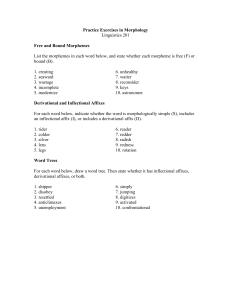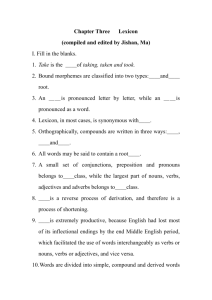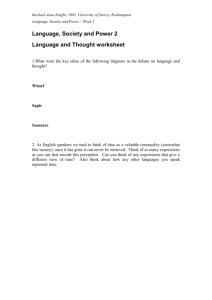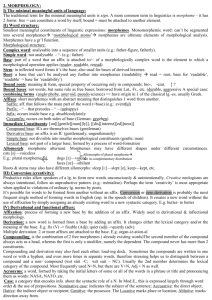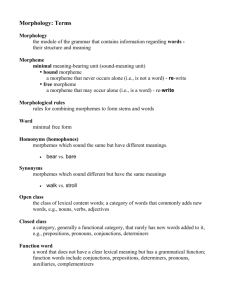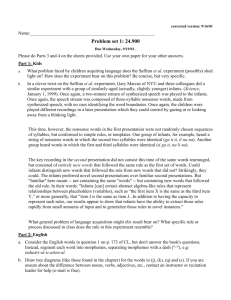Understanding English Variation
advertisement
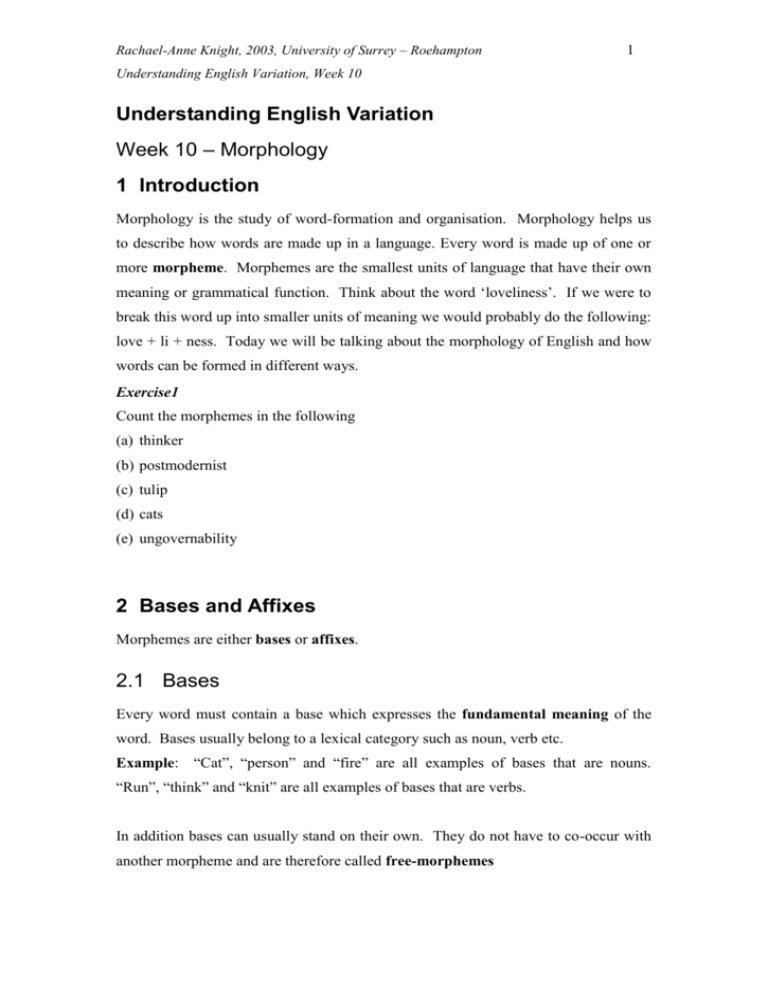
Rachael-Anne Knight, 2003, University of Surrey – Roehampton 1 Understanding English Variation, Week 10 Understanding English Variation Week 10 – Morphology 1 Introduction Morphology is the study of word-formation and organisation. Morphology helps us to describe how words are made up in a language. Every word is made up of one or more morpheme. Morphemes are the smallest units of language that have their own meaning or grammatical function. Think about the word ‘loveliness’. If we were to break this word up into smaller units of meaning we would probably do the following: love + li + ness. Today we will be talking about the morphology of English and how words can be formed in different ways. Exercise1 Count the morphemes in the following (a) thinker (b) postmodernist (c) tulip (d) cats (e) ungovernability 2 Bases and Affixes Morphemes are either bases or affixes. 2.1 Bases Every word must contain a base which expresses the fundamental meaning of the word. Bases usually belong to a lexical category such as noun, verb etc. Example: “Cat”, “person” and “fire” are all examples of bases that are nouns. “Run”, “think” and “knit” are all examples of bases that are verbs. In addition bases can usually stand on their own. They do not have to co-occur with another morpheme and are therefore called free-morphemes Rachael-Anne Knight, 2003, University of Surrey – Roehampton 2 Understanding English Variation, Week 10 2.2 Affixes Affixes add to or change the meaning of a base. They may be classified according to their function and where they occur in relation to the bases. 2.2.1 Prefixes and Suffixes (and Infixes) 2.2.1.1 Prefix Prefixes occur before the base they are attached to. Example: unhappy, relive, 2.2.1.2 Suffix Suffixes occur after the stem. Example: cats, played, terrorise 2.2.1.3 Infix Infixes occur within the stem (generally not in European languages but in many African, Amerindian and Asian languages). Example: In English infixation generally only happens with swear words such as ‘fan – fucking- tastic’ 2.2.2 Derivational and Inflectional Affixes This distinction is determined by the function of an affix. 2.2.2.4 Derivational Affixes Derivational affixes affect the underlying meaning or syntactic category of the base. In English derivational affixes can be either pre- or suffixes. Rachael-Anne Knight, 2003, University of Surrey – Roehampton 3 Understanding English Variation, Week 10 Example: In the word “unhappy” the “un-” affix changes the meaning of the base morpheme from “happy” to “sad” and means ‘negative’. In “terrorise” the affix “-ise” changes the lexical category from noun to verb. Exercise2 For each of the following derivational affixes (a) state another two words which contain the affix (b) state the meaning of the affix (c) state the word class of the base and the word class of the resulting word. -ee as in payee -ism as in feminism -ise as in immunise -ery as in brewery 2.2.2.5 Inflectional Affixes Inflectional affixes do not affect the underlying meaning or class of the base but they do have a grammatical function. Example: In the word “cats” (as in ‘there were two cats’) the “-s” affix functions to show that the word is plural but does not change the underlying meaning or the lexical category of the stem “cat.” Example: In the word cat’s (as in ‘it’s the cat’s bowel’) the –s suffix functions to show that the cat is the owner of the bowel. Affixes in English must be either a prefix or a suffix they cannot be both. Affixes can not generally occur on their own and are called bound-morphemes. To be accurate in our terminology we need to redefine bases. Bases are morphemes which can attach to either an inflectional or derivational affix. We can also talk about stems which are morphemes to which inflectional affixes can attach. (Thus all stems are bases but not all bases are stems.) Rachael-Anne Knight, 2003, University of Surrey – Roehampton 4 Understanding English Variation, Week 10 2.2.2.6 Homophony Sometimes words or morphemes may sound the same but mean different things. Thus ‘their’ and ‘there’ and ‘there’ are homophonous. Sometimes the different meaning is not even reflected in the spelling (bank, letter). Morphemes can also be homophones. Thus in the above example the suffix –s is homophonous. It can mean either plural or possessive. Exercise 3 Divide the following into free and bound morphemes. For bound morphemes say whether they occur as a prefix or suffix in English (a) ation (b) nation (c) pre (d) post (e) angle (f) ible (g) infra (h) out 2.3 Common Problems 2.3.1 Allomorphy The same morpheme can be realised in different ways. These different realisations are called allomorphs. This is usually the result of phonology interacting with morphology. Example: In [] [] [] the highlighted parts are all allomorphs of the plural morpheme //. Rachael-Anne Knight, 2003, University of Surrey – Roehampton 5 Understanding English Variation, Week 10 2.3.2 Irregular Words Irregular words do not obey the general rules for forming plurals or past tenses. However they are still considered to be made up of the same number of morphemes as if they were regular. Example: “Mice” contains two morphemes as it is made up of the root “mouse” and the idea of plurality. “Gave” also contains two morphemes as it made up of the root “give” and the idea of past tense. 2.3.3 Productivity Some affixes are more limited than others in the way they can be used. Exercise 4 Think of examples of the use of the two suffixes –hood and –ness. You’ll probably have found that there are many fewer examples using –hood that able. –hood attaches to nouns that are morphologically simple whilst –ness attaches to adjectives and forms nouns. However, there are many morphologically simple nouns that –hood cannot attach to (e.g. friend, nurse) and therefore we say that it is relatively unproductive. 3 Other methods of word formation 3.1 Compounding In compounding, two independent words are put together to form a new meaning that is not obvious from their individual meanings. For example the compound ‘longboat’ is made up of two independent words ‘long’ and ‘boat’. The meaning is slightly more specialised though and refers to the largest boat carried by a sailing ship. Rachael-Anne Knight, 2003, University of Surrey – Roehampton 6 Understanding English Variation, Week 10 We say that compound nouns are syntactically headed. Thus the syntactic properties of one component decide the syntactic properties of the whole compound. Generally in English compound nouns are right headed so the second element decides the syntactic properties of the compound. In the ‘longboat’ example ‘boat’ is a noun and ‘longboat’ is a noun too. Compound nouns can belong to any major word category. Examples: Noun: Signpost Verb: outlive Adjective: icecold Preposition: into 3.2 Blending Blends are hybrid words. They are rather like compounds except that only part of each individual word has been used. Examples: Smog smoke + fog Brunch breakfast + lunch Oxbridge Oxford + Cambridge 3.3 Acronyms Acronyms are pronounceable words formed from the initial letters of other words. Examples: RAM – random access memory IFAW – international fund for animal welfare BAAP British Association of Academic Phoneticians Rachael-Anne Knight, 2003, University of Surrey – Roehampton 7 Understanding English Variation, Week 10 3.4 Abbreviations Abbreviations are also formed from the initial letters of other words but this time they do not make pronounceable words, and instead the letter names are spoken. Examples: CD – compact disk RSPCA – Royal society for the Prevention of Cruelty to Animals LAGB – Linguistics Association of Great Britain Exercise 5 Think of three more abbreviations and three more acronyms in common usage 3.5 Clipping Clipping involves missing off part of the word to create a word with the same meaning. Either the beginning (fore-clipping), ending (back-clipping) or both ends of the original word may be removed. Exercise 6 What are the unclipped forms of the following words? Has fore- or back-clipping taken place? fridge gym bus lab plane flu 3.6 Backformation Backformation is a rather complex process by which new words are formed. In these instance a word that originally consists of just one morpheme is reanalysed as consisting of two morphemes and then one of these is removed to create a new word. Rachael-Anne Knight, 2003, University of Surrey – Roehampton 8 Understanding English Variation, Week 10 For example, the noun ‘juggler’ existed before the verb ‘to juggle’. Because so many occupations can be formed by adding –er to a noun (‘teacher’, ‘builder’), people began to assume that this must be the case for ‘juggler’ and thus the new verb ‘juggle’ was born. Exercise 7 Have the following words been formed by derivation, inflection, compounding, backformation, acronym, abbreviation, clipping or blending. In cases of derivation and affixation state the base and whether the affix is a prefix or suffix. (1) blackbird (2) NASA (3) TLC (4) peddle (5) oxen (6) chunnell (7) happily (8) goes (9) bike (10) unnecessary References: In addition to the reading on your course guide the following will also be useful for further reading and when completing your assignment Katamba, K. (1994) English Words, London: Routledge (especially chapters 3, 4 and 9) Any good dictionary that gives the etymology of words (Oxford English for example)
